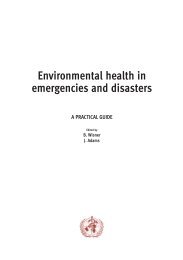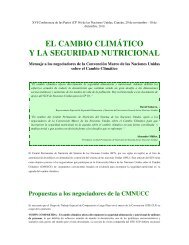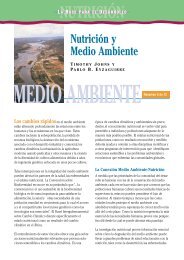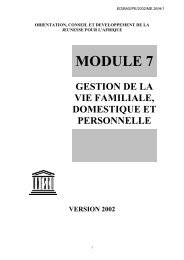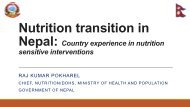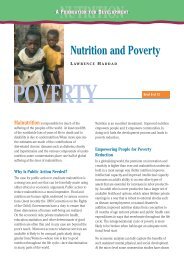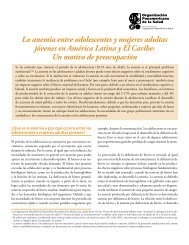SCN News No 36 - UNSCN
SCN News No 36 - UNSCN
SCN News No 36 - UNSCN
Create successful ePaper yourself
Turn your PDF publications into a flip-book with our unique Google optimized e-Paper software.
www.unsystem.org/scn FEATURES 15<br />
appear that growth was protected during the first months of life. These findings highlight the need for prenatal<br />
and early life interventions to prevent growth failure which mainly happens during the first 2-3 years of life.<br />
Understanding the reasons for the high prevalence of stunting in each setting will be important for implementation<br />
of appropriate interventions that will effectively tackle this form of undernutrition. Generally, interventions<br />
should focus on the promotion and protection of exclusive breastfeeding for the first six months of life with<br />
continued breastfeeding until 2 years or more; improving complementary feeding practices, including caregiver<br />
feeding behaviours; and interventions for maternal nutrition to improve pregnancy outcomes. Appropriate<br />
prevention and treatment of common early childhood illnesses would also be essential to improving child growth.<br />
It is well known that complementary feeding diets are frequently deficient in key micronutrients and that the<br />
proportion of energy provided by animal source foods tends to be low. In addition, the common practice of the<br />
early introduction of complementary foods displaces breast milk and increases the chances of infectious<br />
morbidity. Thus, to prevent stunting, greater attention will need to be placed on improving the duration of<br />
exclusive breastfeeding as well as complementary foods and behaviours. Guidelines for complementary<br />
feeding are available (PAHO/WHO 2003; WHO 2004) and it is important that clear and consistent messages<br />
for how to feed infants and young children are disseminated at both facility and community levels. In addition,<br />
maternal education affects how well these messages are received and translated into improved nutrition<br />
outcomes. There is solid empirical evidence showing a strong association between low height-for-age and a<br />
lack of maternal education, with rates of stunting declining as levels of education increase (de Onis 2003).<br />
Therefore, elimination of stunting will require long-term investments to improve maternal education and<br />
empowerment of women, and to reduce current poverty levels.<br />
Although fewer children are severely wasted worldwide compared to those affected by stunting, these children<br />
are at very high risk of death and their treatment should be taken as a priority. The scale up and improvement<br />
of hospital-based case management to prevent this important cause of death is important, however, hospitalbased<br />
management reaches only a small percentage of children. Therefore, equally important will be to<br />
promote the new community-based approach currently recommended by UN agencies as an integral part of<br />
the management of severely wasted children (WHO/WFP/UN<strong>SCN</strong>/UNICEF 2007). This is critical if we are to<br />
reach the majority of children with severe wasting at the large-scale required to significantly impact this<br />
important cause of death.<br />
Conclusions<br />
The causes of growth retardation are deeply rooted in poverty and lack of education. As the WHO Child<br />
Growth Standards demonstrate, children up to the age of 5 years across large populations - regardless of their<br />
racial or ethnic background - grow to remarkably similar heights when given the best possible growth<br />
conditions in early life. To continue to allow underprivileged environments to affect children's development not<br />
only perpetuates the vicious cycle of poverty but also leads to an enormous waste of human potential (Victora<br />
et al 2008). Moreover, a growth standard based on a worldwide sample and recognition that environmental<br />
differences – not genetic endowment – are the principal determinants of disparities in child growth should<br />
contribute to fulfilment of accepted human rights principles, notably those stipulated in the Convention on the<br />
Rights of the Child (WHO 2008b). If the nutritional well-being of people is a precondition for the development<br />
of societies, it is all the more so where their most vulnerable members - children - are concerned. Efforts to<br />
significantly accelerate economic development will be unsuccessful until optimal child growth and<br />
development are ensured for the majority.<br />
The WHO Child Growth Standards have been generally well received, providing an opportunity to redefine,<br />
refocus and reenergize all actions to promote child growth and development. Their introduction into countries<br />
can put a new focus on reducing malnutrition. As part of the implementation process, many countries that<br />
previously only monitored weight-for-age are incorporating the measurement of height which will allow them not<br />
only to assess stunting at an individual level, but equally importantly to monitor the growing problem of childhood<br />
overweight and obesity (WHO 2008c). By doing so they will be better prepared to address the double burden of<br />
malnutrition which increasingly is affecting all developing countries in the world.<br />
back to contents <strong>SCN</strong> NEWS # <strong>36</strong>




